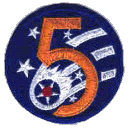As many as fourteen forward-firing .50-caliber guns were added to some later model B-25s, as well as eight five-inch rockets and a 75-mm cannon, which "Pappy" Gunn had perfected. In addition, the B-25H, the most lethal of all B-25s, also was able to carry a hefty 3,000 pounds of bombs. As General Kenney commented in the Air Force article, "The greatest commerce destroyer of the war had been born. We hurriedly remodeled every B-25 we could get our hands on and made the phrase 'air blockade' mean something."

Since the Bismarck Sea action had proved the concept was sound, all light- and medium-bomber pilots were trained in low-altitude bombing techniques. "Jock" Henebry's 3d Bomb Group became especially adept. Further proof came in an attack at Rabaul on November 2,1943, a date that ranks with the Bismarck Sea battle in the history of the war in the South Pacific.
While six P-38 squadrons flew top cover, Maj. Ben Fridge, with four squadrons of B-25s, machine-gunned and dropped phosphorous bombs on antiaircraft positions. Henebry led his five squadrons into Rabaul Harbor through the smoke of the phosphorous bombs at masthead height. "Of the thirty-eight vessels. . . and twenty merchant ships. . . in the harbor that day," Kenney reported, "thirty received direct hits in the toughest, hardest-fought engagement of the war. The list included one heavy cruiser, one destroyer tender, one submarine tender, three destroyers, two naval auxiliary craft, three minesweepers, sixteen merchant vessels, two tankers, and a tug."

Although from fifty to sixty enemy fighters were expected, 125 to 150 showed up and dove through the P-38s to get at the B-25s. Sixty-eight Japanese fighters were destroyed by the P-38s and B-25s, with twenty-three probables. In addition, Fridge's B-25s destroyed ten floatplanes sitting at anchor, as well as other aircraft on the Lakunai Airdrome. US losses were six B-25s, with three missing, and nine P-38s, with eight of them missing.
Kenney reported:
"In the space of twelve minutes, we had destroyed or damaged 114,000 tons of Japanese shipping, shot down or destroyed on the ground eighty-five. . . airplanes, and burned out half the town of Rabaul, with a loss of supplies to the enemy estimated at 300,000 tons."

"Jock" Henebry did not escape the enemy's wrath unscathed. He had to ditch his B-25 after it was riddled with bullet and shell holes and one engine was shot out. He and his crew were rescued later that day.
In writing about the Bismarck and Rabaul battles in his personal history of the war, General Kenney, declared, "Never in the long history of warfare had so much destruction been wrought upon the forces of a belligerent nation so swiftly and at such little cost to the victor."
General Kenney, a contemporary of Billy Mitchell's who agreed with the great crusader's airpower postulates, must have taken special pride in writing that statement. After the 1921 bombing tests off the Atlantic coast, Mitchell had declared, "No surface vessels can exist wherever air forces acting from land bases are able to attack them." General Kenney's low-flying B-25 mediums, appropriately named for Mitchell, proved beyond all doubt that he was right.

Both tactically and strategically, this was an outstanding operation. Besides the ships sunk, from 59 to 83 planes had been shot down and at least 9 others damaged. The Army Air Forces lost 1 B-17 and 3 P-38's in combat, and a B-25 and a Beaufighter through other causes. Total Army Air Forces personnel losses came to 13 while the Japanese lost approximately 12,700 officers and men. Entirely unassisted, the Fifth Air Force, besides disposing of large numbers of airmen and sailors, wiped out an entire division of troops. Thus the Fifth Air Force, operating in conjunction with our amphibious, naval and land forces in and around the Solomons and New Guinea, had seized the initiative in the Southwest Pacific. For the first time in that theater we were able to strike at times and places of our own choosing.
